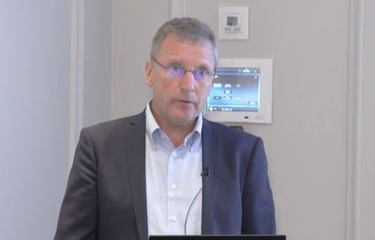Grieg Seafood Group (GSF) achieved operational earnings before interest and taxes (EBIT) of NOK 986 million (USD 101.4 million, EUR 101.6 million) before fair-value adjustment of biomass in Q2 2022, eclipsing the NOK 44 million (USD 4.5 million, EUR 4.5 million) the company brought in during the corresponding period of 2021.
Driven by exceptionally high salmon prices and a good biological performance, the Bergen, Norway-headquartered salmonid producer reported an EBIT-per-kilogram for the period of NOK 41.60 (USD 4.27, EUR 4.28), which was 17 times what it had achieved in Q2 2021.
Total sales revenues during the three-month period amounted to NOK 2.35 billion (USD 241.6 million, EUR 242 million), double that of Q2 2021.
"As a continuation of the positive trend in Q1, the second quarter of 2022 also turned historic. Due to the strongest market the industry has seen, coupled with solid production, I am proud to present Grieg Seafood's best result in a single quarter ever,” Grieg CEO Andreas Kvame said.
GSF harvested 23,700 metric tons (MT) of gutted-weight salmon in the quarter, 5,900 MT more than in the corresponding period of last year. Regionally, Finnmark, Norway provided the most fish with 9,843 MT, followed by British Columbia, Canada (8,815 MT), and Rogaland, Norway (5,014 MT).
According to its Q2 report, GSF’s results in Rogaland and Finnmark were positively impacted by strong price realization from high average harvest weights and positive cost developments, while its B.C. harvests were solid and achieved good prices and premiums on value-added products, in addition to stable costs from the harvesting of sites with good biological performances.
Meanwhile, in Newfoundland, Canada, Grieg’s fish currently in the water have been performing well, with a high survival and no sea lice issues. Currently, two million smolt have been transferred, with harvesting due to commence in late 2023.
GSF’s sales revenues for the first half of 2022 exceeded NOK 3.8 billion (USD 390.7 million, EUR 391.3 million), again twice that of H1 2021, while its harvest volume for the six-month period climbed to 40,588 MT. This contributed to an EBIT before fair-value adjustments of biological assets of more than NOK 1.4 billion (USD 143.9 million, EUR 144.1 million), up from NOK 28 million (USD 2.9 million, EUR 2.9 million), and was equivalent to an EBIT-per-kilogram of NOK 35.50 (USD 3.65, EUR 3.66), compared with just NOK 0.90 (USD 0.09, EUR 0.09) in H1 2021.
Grieg’s profit before tax for the year to-date was more than NOK 1.7 billion (USD 174.7 million, EUR 175 million), up from the NOK 282 million (USD 29 million, EUR 29 million) it reported for the first six months of last year.
For the third quarter of 2022, GSF’s expects a harvest volume of 21,400 MT, with Rogaland and Finnmark producing 7,100 MT each, and BC with 7,200 MT. The group has now revised its previous 2022 harvest volume target of 90,000 MT down by 3,000 MT.
Grieg said its estimated harvest volume in Finnmark has been reduced by 2,000 MT to 36,000 MT due to an expedited harvest to capitalize on the current strong market and somewhat reduced growth in sea during the quarter as a result of lower temperatures. Additionally, the estimated harvest volume in B.C. has been reduced by 1,000 MT to 21,000 MT due to accelerated harvest of fish due to risk of early maturation.
Of the total harvest volumes for 2022, Grieg Seafood expects to sell some 5 to 10 percent of its fish as value-added products.
GSF’s financials also project that the global harvest of Atlantic salmon will decrease by 1 percent for the year, with all the world’s major salmon-producing regions seeing declining volumes. In the first half of 2022, the global harvest was down 4 percent compared to the corresponding period of 2021, and consequently, the harvest volume for the second half of 2022 is expected to increase by close to 1 percent.
With limited supply growth in the second half of 2022, Grieg said it expects good market conditions going forward. However, it added that with current inflation reducing household purchasing power, the global foodservice and retail segments could be impacted.
According to the Q2 report, the average spot salmon price for Norwegian salmon in the quarter was NOK 105.70 (USD 10.86, EUR 10.88) per kilogram, up by NOK 43.60 (USD 4.48, EUR 4.49) per kilogram compared to Q2 2021, and by NOK 26.30 (USD 2.70, EUR 2.71) per kilogram compared to Q1 2022.
Prices started above NOK 100 (USD 10.28, EUR 10.30) going into the period, peaked above NOK 123 (USD 12.64, EUR 12.67) per kilogram in the beginning of May, and ended just under NOK 100 at the end of the quarter, it said.
Grieg also acknowledged paying NOK 155 million (USD 16 million, EUR 16.1 million) to settle one of several civil claims of price-fixing brought by U.S. consumers in response to ongoing U.S. and European Union investigations into Norwegian salmon producers. According to Grieg, the settlement involved U.S. direct-purchaser plaintiffs, and another suit involving indirect customers remains pending, as do three cases in Canada. Grieg "rejects that there is any basis for the claims and considers the complaints to be entirely unsubstantiated," but said it paid the settlement – still subject to approval from a court in the U.S. state of Florida – due to the cost and time involved in U.S. litigation.
Photo courtesy of Grieg Seafood







